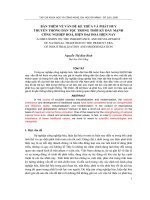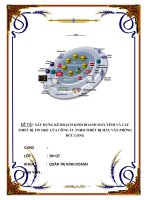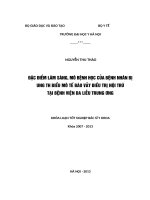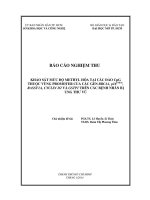Báo cáo nghiên cứu khoa học: " Nghiên cứu về nhiễm HBV mãn tính và các yếu tố gây nhiễm ở những bệnh nhân bị ung thư gan trong bệnh viện của trường Cao đẳng Y Dược Huế" pdf
Bạn đang xem bản rút gọn của tài liệu. Xem và tải ngay bản đầy đủ của tài liệu tại đây (95.26 KB, 8 trang )
459
JOURNAL OF SCIENCE, Hue University, N
0
61, 2010
RESEARCH ON CHRONIC HBV INFECTION AND
RISK FACTORS IN PATIENTS WITH LIVER CANCER IN
THE HOSPITAL OF HUE COLLEGE OF MEDICINE AND PHARMACY
Vo Dang Anh Thu, Nguyen Thi Kim Hoa, Pham Van Linh
College of Medicine and Pharmacy, Hue University
SUMMARY
Research on the risk factors of liver cancer, particularly HBV infection is necessary for
preventing liver cancer and to reduce the prevalence of this cancer in future. Objectives: To
identify the risk factors among patients with liver cancer in Hue college of Medicine and
Pharmacy. Methods: A case-control study was conducted from May 2007 to May 2008 in which
there were 40 patients with liver cancer and 40 people without any liver diseases. For each
patient, there was a person in the control group has the same age, gender and living areas.
Results: (1) The average age of the study subjects was 53.7±8.9 in which age 54.3±12.1 was the
mean for men and age 52.9±8.9 for women, 50% of liver cancer patients aged from 45 to 60.
The ratio of men to women was 3 to 1. (2) The risk factors of liver cancer include: HBsAg (+)
(OR = 17.0), history of alcohol consumption (OR=7.0), drinking frequency (OR=4.5), the
volume of alcohol intake (OR=5.18), tobacco consumption (OR = 2.51), familial history of liver
cancer (OR = 5.52). (3) The exposure to organic pesticides is not associated with liver cancer
(OR=1.48, p>0.05, χ
2
= 0.39). Conclusion: This research was useful in identifying risk factors
of liver cancer. The results from this research will be used to inform the community and future
study of the risk factors of liver cancer.
1. Introduction
Liver cancer is one of the most common cancers worldwide. This is the fifth
most common cause of cancer in men and the eighth most common cause in women. In
Vietnam, liver cancer is also a common and serious cancer that affects men more often
than women, and which was ranked the third most common cancer in men and the sixth
in women. As in many Asian countries, Vietnam is one of the countries that have a high
prevalence of liver cancer due to the high proportion of hepatitis B and C infection.
Major risk factors of hepatocellular carcinoma are hepatitis B and C. Thereto,
alcohol and cirrhosis also largely contribute to the causes of this serious cancer. One
study has shown that alcoholics were two times more likely than non-alcoholics to
develop liver cancer, and twenty-two times more likely to develop liver cancer if there
460
was cirrhosis induced by alcohol. Meanwhile, aflatoxin B1 is the main causal factor of
live cancer due to chemicals. Research on risk factors of liver cancer, particularly HBV
infection are necessary for preventing liver cancer and contributing to the reduction in
the prevalence of this cancer in the future. This study was conducted in order to
determine the relationship between chronic hepatitis B virus infection and other risk
factors among patients with liver cancer.
2. Methodology
A case-control study was done from May 2007 to May 2008.
2.1. Sample
Using the formula of Schlesselman
3
:
Predicted: f = 0.35; OR = 3.5; accepted: = 0.05; = 0.2; → n
40
2.2. Selection of cases and controls
The cases were 40 patients with liver cancer who were under treatment at the
hospital of Hue college of Medicine and Pharmacy. Under the principle of the same
living area, sex and age, 40 non-liver cancer subjects were selected as controls.
Consequently, the study subjects include 40 cases and 40 controls.
2.3. Contents of the study
The study contents composed of three parts as follow: (1).General
characteristics; (2). Personal habits: including alcohol consumption and cigarette
smoking; (3). Symptoms and disease history related with liver cancer.
2.4. Investigation methods
the constructed questionnaire was used to collect data. All interviewers were
trained focusing on the skills of interviewing the subjects. No subjects refused to be
interviewed.
2.5. Statistical analysis
Classical analysis methods of case-control study was used to analyze data. OR
value and χ
2
were calculated. In this study, the EPI INFO 6.04 was used for completing
all the statistical analyses.
2
3
2
33βα
pf
qpf1fZu12uZ
n
1ORf1
OR
1f
2
1
u
1ORf1
fOR
p
3
33
p1q
461
3. Results
Table 1. Age
Age Frequency %
15 - 30 0 0
> 30 - 45 10 25
> 45 - 60 20 50
> 60 10 25
Sum 40 100
*There was 50% liver cancer patients aged 45-60.
Table 2. Sex
Sex Frequency %
Male 30 75.0
Female 10 25.0
Sum 40 100
*Men have higher proportion of liver cancer than women; the ratio of men to
women is three to one.
Table 3. The situation of hepatitis B infection among patients with liver cancer
HBsAg
Cases
n %
(+) 30 75.0
(-) 10 25.0
Sum 40 100
*75% patients with liver cancer have HBsAg (+)
Table 4. The relation between hepatitis B infection and liver cancer
Cases Controls
HBsAg(+) 30 6 36
HBsAg(-) 10 34 44
40 40 80
462
OR = 17.0
95%CI of OR = (4.91 – 62.64)
χ
2
= 29.1
p < 0.001
Table 5. The relation between contracting hepatitis B in history and liver cancer
Cases Controls
Yes 14 3 17
No 26 37 63
40 40 80
OR = 6.64
95%CI of OR = (1.55 – 32.62)
χ
2
= 9.04
p < 0.01
Table 6. The relation between history of alcohol consumption and liver cancer
Cases Controls
Yes 30 12 42
No 10 28 38
40 40 80
OR = 7.00
95%CI of OR = (2.36 – 21.39)
χ
2
= 16.24
p < 0.001
Table 7. The relation between alcohol drinking frequency and liver cancer
Cases Controls
Frequent 18 3 21
No frequent 12 9 21
30 12 42
OR = 4.50
95%CI of OR = (0.84 – 26.75)
463
χ
2
= 4.20
p < 0.05
Table 8. The relation between the daily volume of alcohol intake and liver cancer
Cases Controls
≥ 30 gammes 19 3 22
< 30 gammes 11 9 20
30 12 42
OR = 5.18
95%CI of OR = (0.96 – 31.12)
χ
2
= 5.05
p < 0.05
Table 9. The relation between history of exposure to chemicals and liver cancer
Cases Controls
Yes 7 5 12
No 33 35 68
40 40 80
OR = 1.48
95%CI of OR = (0.37 – 6.09)
χ
2
= 0.39
p > 0.05
Table 10. The relation between history of tobacco smoking and liver cancer
Cases Controls
Smoking 26 17 43
Non-smoking 14 23 37
40 40 80
OR = 2.51
95%CI of OR = (0.93 – 6.88)
χ
2
= 4.07
p < 0.05
464
Table 11. The relation between family history with liver cancer and liver cancer
Cases Controls
Yes 9 2 11
No 31 38 69
40 40 80
OR = 5.52
95%CI of OR = (0.99 – 40.12)
χ
2
= 5.16
p < 0.05
4. Discussion
4.1 General characteristics
Age
In this study, there was no patient under thirty years old and the average age of
the subjects was 53.7±8.9 in which 54.3±12.1 for men and 52.9±8.9 for women. Of the
40 cases, there were 20 (50%) patients aged from 46 to 50. This figure is approximate
with previous national and international studies.
Sex
Men are more likely to contract liver cancer than women. The ratio of male
patients to female patients in this study was 3 to 1. Several studies have suggested that
hormone androgen facilitates the development of the tumors, whereas oestrogen in
women has a protective effect. In addition, men have greater risk factors of liver cancer
than women including smoking and alcohol consumption.
4.2 The relation between chronic hepatitis B virus infection and liver cancer
The prevalence of patients with liver cancer having HBsAg (+) was 75 percent.
Meanwhile, in the control groups, there were only 15 percent of the subjects having
HBsAg (+). Therefore, patients who have HBsAg (+) get the higher risk of contracting
liver cancer than people with HBsAg (-) (OR = 17, p <0.01, χ2 = 29.1).
4.3. Other risk factors of liver cancer
Alcohol consumption
Research has shown that there was an association between drinking frequency
and the volume of alcohol intake with liver diseases. To examine the association
between alcohol consumption with liver cancer, the history of alcohol consumption,
drinking frequency and the volume of alcohol intake of the subjects were analyzed. Of
465
the 40 liver cancer patients, there were 30 (75%) patients having the history of alcohol
consumption. In comparison with the control groups, this can be concluded that alcohol
drinkers would get 7 times greater risk of contracting liver cancer than non-drinkers
(OR=7.0, p<0.01, χ
2
=16.24). In addition, alcohol can interrelate with hepatitis B in the
pathogenesis of liver cancer
1
.
The result of this study has demonstrated that there was a strong relation
between the drinking frequency and liver cancer. Frequent drinkers have more 4.5 times
at risk of liver cancer than non-frequent drinkers (OR=4.5, p<0.05, χ
2
=4.2). Frequently
consuming alcohol can speed up the progress of the development of liver lesions to liver
cancer. The structure and function of the liver can be recovered by ceasing to drink
alcohol. However, if alcohol consumption has occurred over many years, it can lead to
permanent lesions of the liver. Viral hepatitis often occurs in alcoholics. Both viral
hepatitis and alcoholism can lead to cirrhosis which promotes the development of liver
cancer.
Regarding the volume of alcohol intake, research has shown that daily
consuming 30 grammes of ethanol on average can lead to the high risk of cirrhosis . The
results of this study pointed out that the subjects who drunk more than 30 gammes of
alcohol daily had more 5.18 times at risk of liver cancer than the light drinking subjects
(OR=5.18 với p<0.05 và χ
2
=5.18).
Tobacco consumption
Though toxic components of tobacco are transformed in the liver, little research
has been done on the relationship between tobacco consumption and the liver’s lesions.
In this study, patients with a history of tobacco consumption (accounted for 42.5%) had
a 2.51 times higher risk of liver cancer than non-smokers (OR = 2.51, p < 0.05, χ
2
=
4.07).
Exposure to chemicals
In the world, there are 6,000 cases of cancer of all kinds due to pesticides
annually. The halogenated organic pesticides is not a harmful carcinogen for the liver,
but is a promoter stimulating unlimited liver cell proliferation which is believed to play
an important role in the development of liver cancer. However, this study showed that
the exposure to organic pesticides did not reveal a relationship to liver cancer (OR=1.48,
p>0.05, χ
2
= 0.39).
Familial history of liver cancer
Several studies have mentioned familial history as an important factor of liver
cancer. The results from table 11 shows that subjects who have relatives who contracted
liver cancer get more than 5.52 times higher at risk of liver cancer than those who have
not (OR = 5.52, p < 0.01, χ
2
= 5.16). Particularly, this happens more often among
466
patients having HBsAg(+).
5. Conclusion
Overall, this research was useful in identifying risk factors of liver cancer. The
results from this research will be used to inform the community and future study of the
risk factors of liver cancer including HBsAg (+), history of alcohol consumption,
drinking frequency, the volume of alcohol intake, tobacco consumption and familial
history of liver cancer. Thereto, the exposure to organic pesticides is not associated with
liver cancer.
REFERENCES
1. Dominguez, MH., Gaytan, GS. Hepatocellular Carcinoma. Ultra structural Pathology,
25(6), (2001), 497-516.
2. Lee, JH., Oh, BK., Choi, J., Park, YN. Telomeric 3’ overhangs in chronic HBV-related
hepatitis and hepatocellular carcinoma. International journal of cancer, 123, (2008),
264-272
3. Dinh Thanh Hue. Theory of origin and analytical study by observing. Epidemiological
methods, (2004), 103-108.
4. Pham Van Linh, Pham Anh Vu, Duong Thi Hao. Research on the values of laboratory
tests of diagnosing liver cancer. Vietnamese medical journal, 297, (2004), 152-157.
5. Brown, LM. Epidemiology of alcohol-associated cancers, Alcohol, 35(3), (2005), 161-
168.









